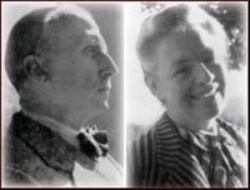Blessed Luigi and Maria Beltrame Quattrocchi and St Catherine of Alexandria

Luigi and Maria Beltrame Quattrocchi
Married couple. Luigi and Maria Beltrame Quattrocchi were beatified on October 21, 2001 by Pope John Paul II.
The couple lived in Rome. Maria was an academic and educationalist and worked for several Catholic organisations. She died in 1965. Luigi was a lawyer involved in the reconstruction of Italy after the Second World War. He died in 1951. Three of their four children attended the ceremony.
"The richness of faith and married love shown by Luigi and Maria Beltrame Quattrocchi is a living demonstration of what the Second Vatican Council said about all the faithful being called to holiness,'' the Pope said in his homily. "They lived an ordinary life in an extraordinary way,'' demonstrating that sainthood for married couples is "possible and beautiful.''
The Pope assigned today as the Feast Day for Luigi and Maria. Usually, the Feast Day for a saint is the date of their death; however, since the couple has two different dates of death, in an unprecedented step, celebrating their life as a couple, today was chosen because it marks the anniversary of their marriage in 1905.
St Catherine of Alexandria
As with many early saints, the historical facts of Catherine's life are slightly confusing. According to historical tradition some key facts emerge. It is held that she was the daughter of Constus, a governor of Alexandria during the reign of the emperor Maximian (286-305). The city of Alexandria was both important and famous in the ancient world. It was an important centre of Hellenistic culture and the capital of Roman and Byzantine Egypt for almost 1000 years, and it was famous for its Great Library, which was the largest in the ancient world. Catherine is believed to have devoted herself to study from an early age and, due to a visionary experience of the Theotokos, she became a Christian.
When the persecutions began under the next emperor Maxentius, Catherine is said to have gone before the emperor and rebuked him for his cruelty. Tradition states that the emperor summoned fifty of the best pagan philosophers and orators to dispute with her, hoping that they would easily refute her pro-Christian arguments. Instead, through her intellect and eloquence, Catherine won the debate, but consequently suffered torture and martyrdom. The story tells us that the spiked wheel by which she was to be killed broke when she touched it (hence the term Catherine wheel), and she was then beheaded. It was said some of her adversaries were so impressed by her intellect, spirited defence and advocacy, that they declared themselves Christians, suffering martyrdom themselves as a result.
The confusion and lack of historical evidence for her life does not mean that she did not exist in the living tradition of the Christian community as one of the 'virgin martyrs' - a specific group of saints who suffered untimely death on account of their faith. Her body was said to have been discovered at Mount Sinai around AD 800, having been earlier brought there by angels, since when she has been venerated there in the Orthodox monastery named after her. Churches named after Saint Catherine became the site of pilgrimages for believers. She gained a cult-like following in the Middle Ages, and it was said that Joan of Arc heard her voice in her well-publicized visions of heaven.
While Saint Catherine is the patron saint of many causes and locations that have claimed her intercession over the years, she is best known as the patron saint of students. She is also revered as the patron saint of unmarried girls and apologists, on account of her death as a virgin, her refusal of marriage to the pagan Emperor, and her mastery of apologetics in defending the Gospel. Over time, she also became honoured as a heavenly intercessor for craftsmen who worked with wheels (due to her miraculous breaking of the wheel of torture that was to kill her), as well as for others who work in education, such as teachers and librarians.












